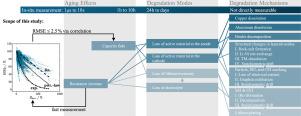How degradation of lithium-ion batteries impacts capacity fade and resistance increase: A systematic, correlative analysis
IF 7.9
2区 工程技术
Q1 CHEMISTRY, PHYSICAL
引用次数: 0
Abstract
Lithium-ion batteries play an essential role in a wide range of applications. It is, therefore, crucial to accurately determine their state of health, which is characterized by capacity fade and resistance increase. Their interdependency has received limited attention and this study places special emphasis on their linkage. We analyzed aging studies incorporating over 814 cells featuring NMC, NCA, and LFP chemistries and found a strong negative Pearson’s correlation coefficient () for capacity fade and resistance increase in over 97 % of the cells investigated. This confirms that aging mechanisms affect both indicators simultaneously. We developed a power-law fit that accurately captures capacity fade with root mean square errors below 2.5 % up to at least a state-of-health of 70 %. Additionally, our findings integrate multiple aging pathways into a single analytical framework, offering a practical tool for determining battery life and improving reliability in modern power applications. We show that both resistance and impedance are closely related to aging. Therefore, evaluating either one of them in experimental studies for performance analysis and incorporating them into machine learning feature sets should be mandatory for a comprehensive investigation of battery aging.

锂离子电池退化如何影响容量衰减和电阻增加:一个系统的、相关的分析
锂离子电池在广泛的应用中发挥着至关重要的作用。因此,准确确定它们的健康状况至关重要,其特征是能力衰退和抵抗力增强。它们的相互依赖性受到的关注有限,本研究特别强调它们之间的联系。我们分析了超过814个具有NMC、NCA和LFP化学成分的细胞的衰老研究,发现超过97%的细胞的容量衰减和抗性增加具有很强的负Pearson相关系数(r<−0.8)。这证实了衰老机制同时影响这两个指标。我们开发了一种幂律拟合,可以准确地捕获容量衰减,均方根误差低于±2.5%,直至至少70%的健康状态。此外,我们的研究结果将多种老化途径整合到一个分析框架中,为确定电池寿命和提高现代电源应用的可靠性提供了实用工具。我们发现电阻和阻抗都与老化密切相关。因此,在实验研究中评估它们中的任何一个进行性能分析,并将它们纳入机器学习特征集,应该是全面研究电池老化的必要条件。
本文章由计算机程序翻译,如有差异,请以英文原文为准。
求助全文
约1分钟内获得全文
求助全文
来源期刊

Journal of Power Sources
工程技术-电化学
CiteScore
16.40
自引率
6.50%
发文量
1249
审稿时长
36 days
期刊介绍:
The Journal of Power Sources is a publication catering to researchers and technologists interested in various aspects of the science, technology, and applications of electrochemical power sources. It covers original research and reviews on primary and secondary batteries, fuel cells, supercapacitors, and photo-electrochemical cells.
Topics considered include the research, development and applications of nanomaterials and novel componentry for these devices. Examples of applications of these electrochemical power sources include:
• Portable electronics
• Electric and Hybrid Electric Vehicles
• Uninterruptible Power Supply (UPS) systems
• Storage of renewable energy
• Satellites and deep space probes
• Boats and ships, drones and aircrafts
• Wearable energy storage systems
 求助内容:
求助内容: 应助结果提醒方式:
应助结果提醒方式:


